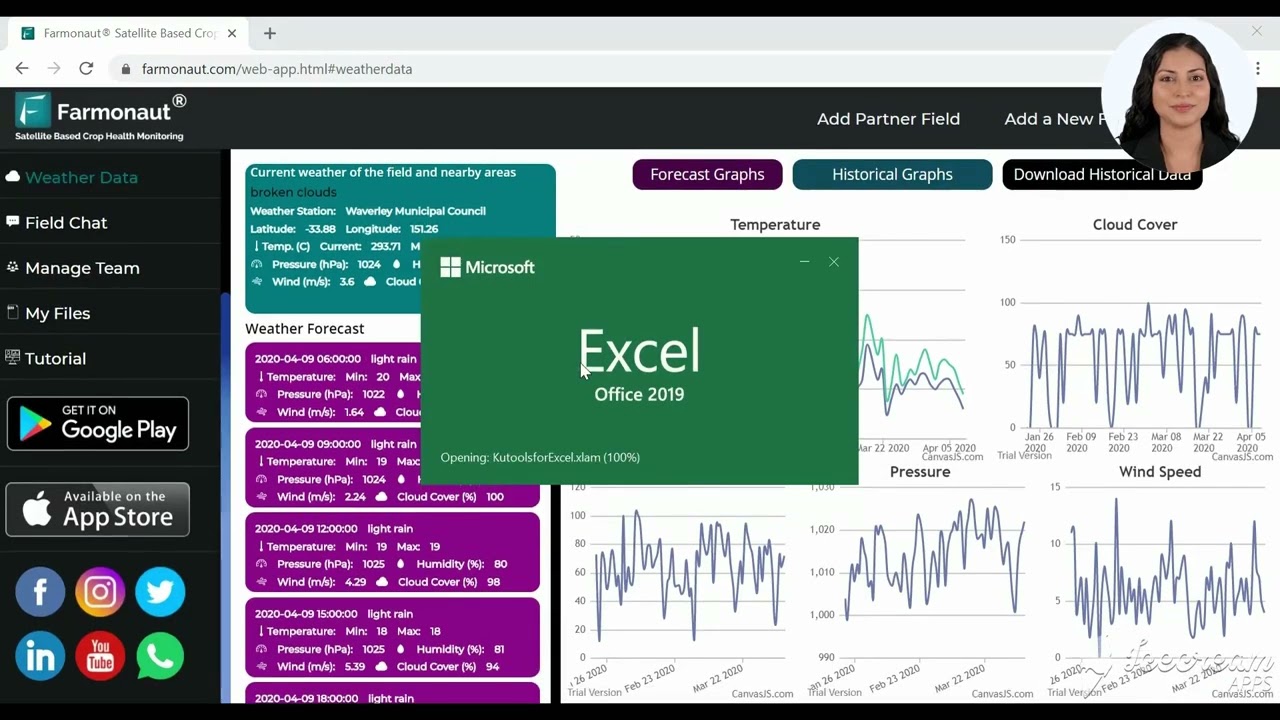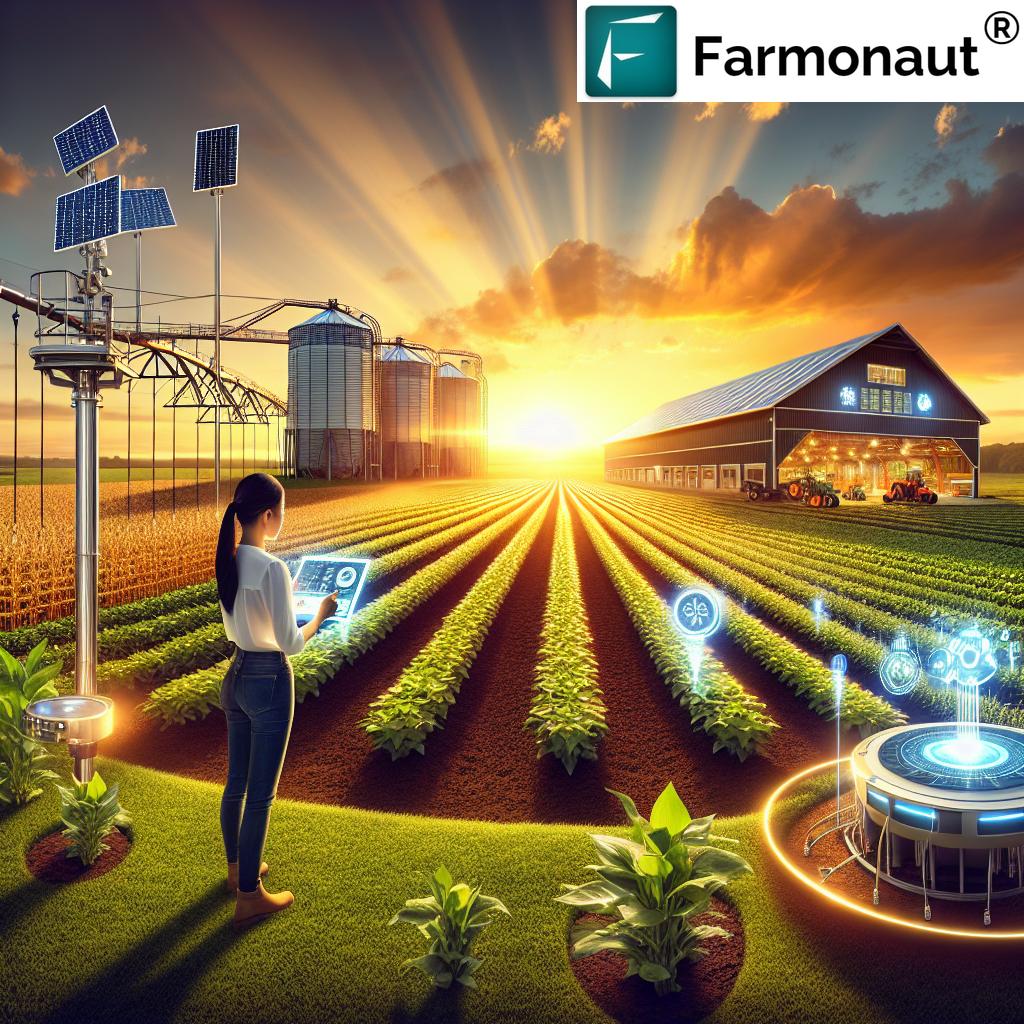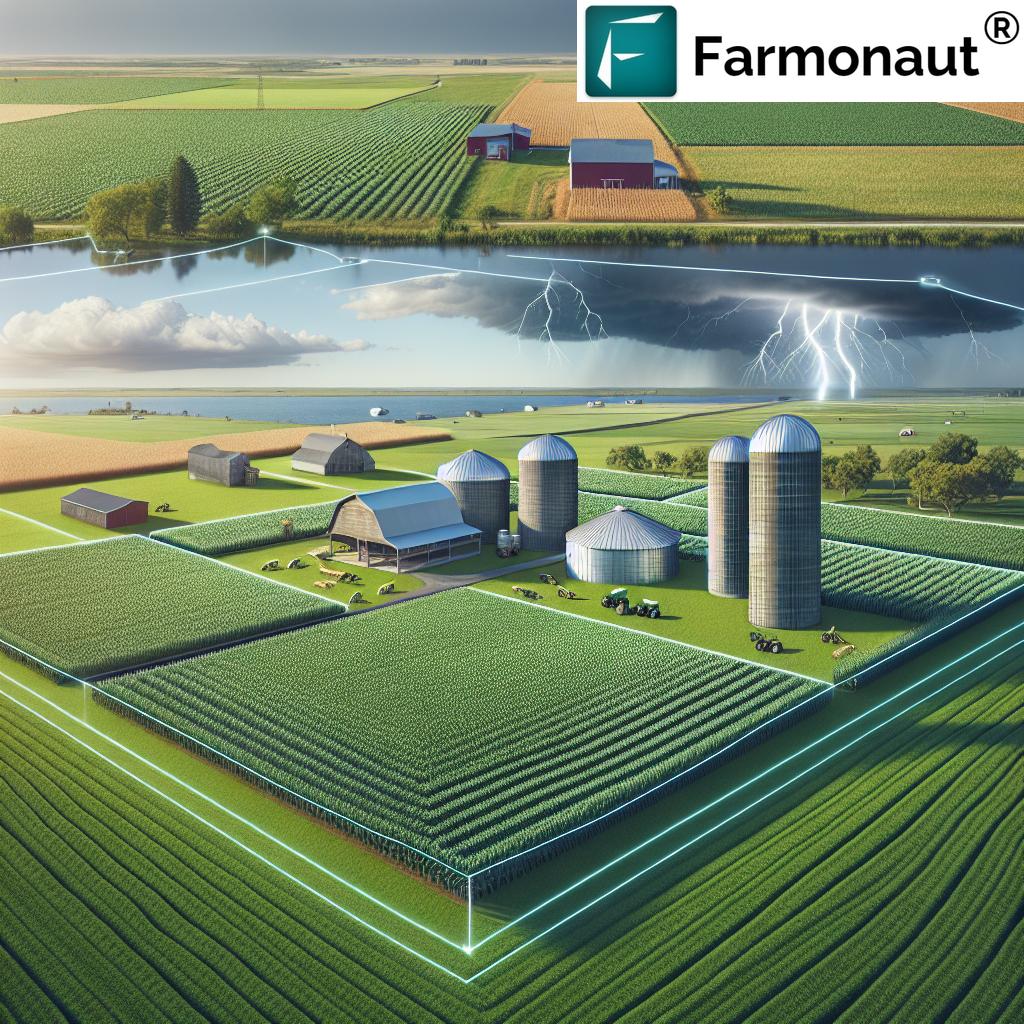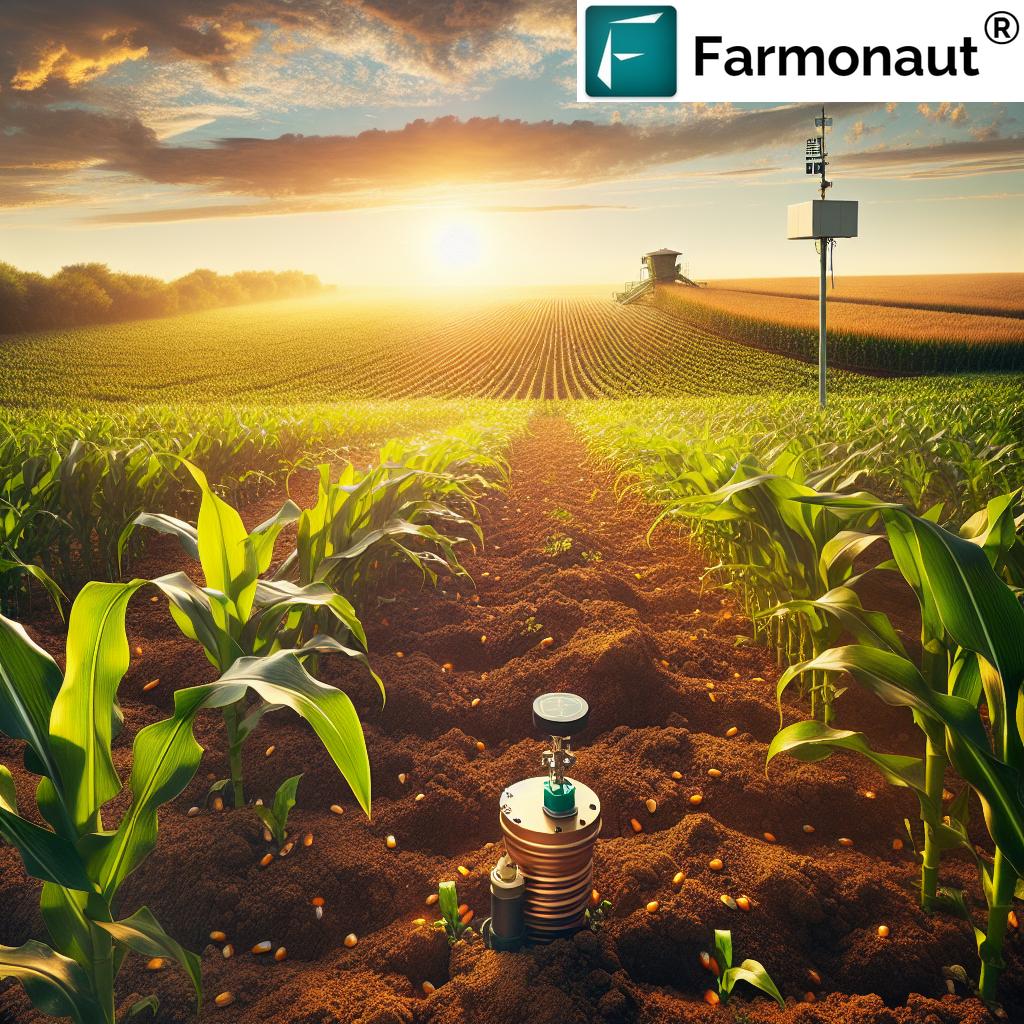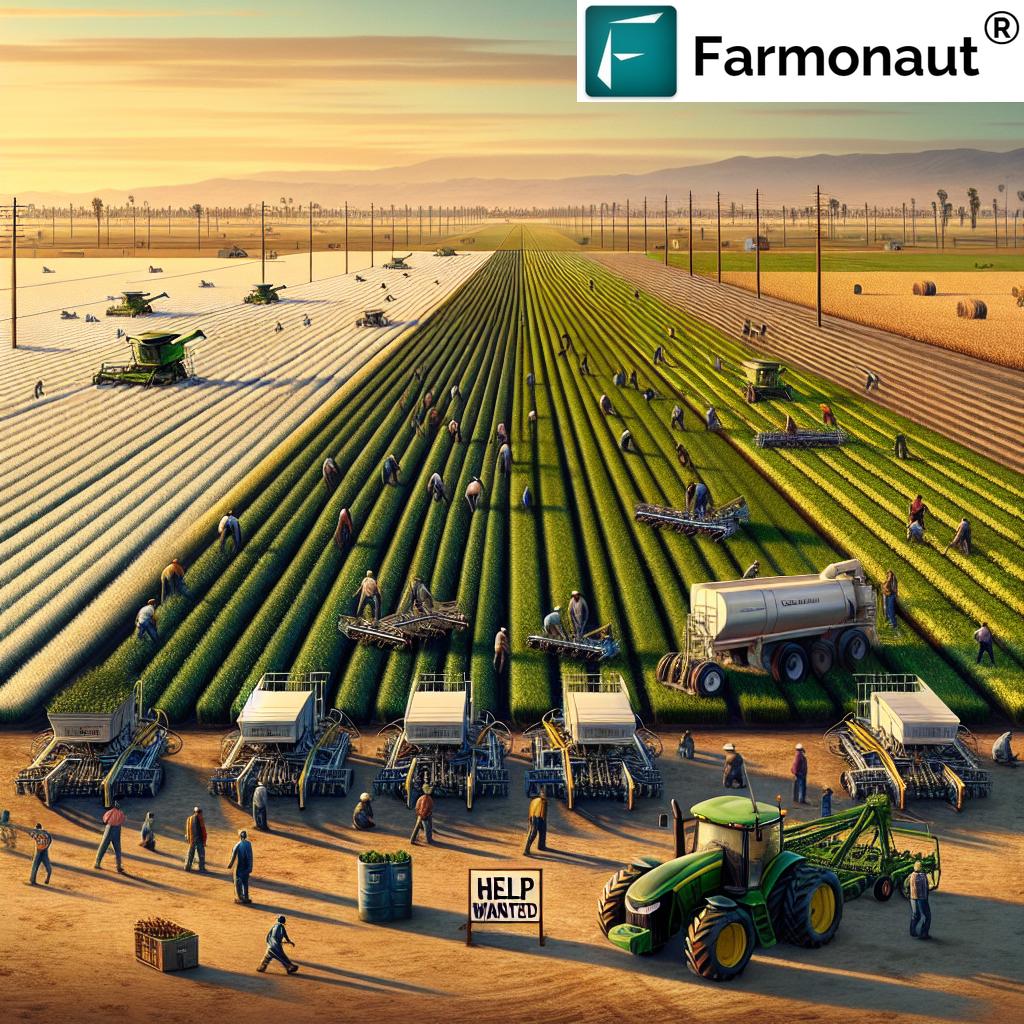Climate-Resilient Agriculture: How Farmonaut’s Research Combats Flooding Impacts on Crops in Illinois

“UN’s 2024 report reveals inadequate climate plans, highlighting urgent need for climate-resilient agriculture in face of extreme weather events.”
In the face of escalating climate change impacts, the agricultural sector finds itself at a critical juncture. As we delve into the challenges posed by extreme weather events, particularly flooding, in Illinois and beyond, we must explore innovative solutions and sustainable farming practices that can help mitigate these impacts. This blog post examines the urgent need for climate-resilient agriculture and how cutting-edge research, including Farmonaut’s contributions, is paving the way for a more sustainable future.
The Growing Threat of Climate Change to Agriculture
The United Nations’ recently released 2024 Nationally Determined Contributions synthesis report paints a sobering picture of our global climate preparedness. Current national climate plans are falling short, a fact that becomes increasingly alarming as we witness the adverse economic impacts of climate change unfolding before our eyes.
This year alone, we’ve seen a barrage of climate-related disasters striking numerous countries, including the United States. Flooding, extreme heat, drought, and pest outbreaks have exposed the vulnerabilities in our climate resilience strategies. According to the National Oceanic and Atmospheric Administration (NOAA), climate-related disasters in the US have already exceeded $1 billion in losses this year.
Flooding: A Persistent Threat to Crops
Among these climate disasters, flooding consistently ranks as one of the top three most destructive events. Its impact is far-reaching, affecting not only human lives but also causing immense damage to livestock, poultry, and agricultural crops. In Illinois, a state known for its rich agricultural heritage, the threat of flooding poses a significant risk to food security and economic stability.
To better understand the scale of this problem, let’s examine a comparison of climate change impacts on major crops in Illinois:
| Crop Type | Average Annual Yield (pre-climate change) | Estimated Yield Loss Due to Flooding (%) | Potential Economic Impact ($USD millions) |
|---|---|---|---|
| Corn | 175 bushels/acre | 15-25% | 800-1300 |
| Soybeans | 55 bushels/acre | 10-20% | 400-800 |
| Wheat | 70 bushels/acre | 5-15% | 50-150 |
| Specialty Crops | Varies | 20-30% | 100-200 |
This table illustrates the varying impacts of flooding on different crop types in Illinois, highlighting the urgent need for climate-resilient agriculture strategies.
The Role of Research in Combating Flooding Impacts
As we approach COP29, discussions around climate change impacts on agriculture are gaining momentum. However, it’s crucial to note that the detrimental effects of flooding on plants have often been overlooked in these conversations. This oversight is particularly concerning given that multiple climate-related events frequently occur simultaneously, compounding their negative impacts on livelihoods and economies.
Investing in research related to emerging climate threats, especially flooding, is essential for enhancing climate resilience. Without such investment, we risk facing future food shortages, volatile prices, and potential conflicts over scarce resources. Research initiatives aimed at developing flood-tolerant crops and sustainable recovery products can significantly mitigate the adverse effects of flooding on agriculture.
Farmonaut’s Contribution to Climate-Resilient Agriculture
In this context, Farmonaut’s research and technological solutions play a crucial role in supporting farmers and agricultural stakeholders. By leveraging satellite-based farm management solutions, Farmonaut provides valuable tools for precision agriculture and climate adaptation.
Farmonaut’s platform offers real-time crop health monitoring, which is invaluable for farmers dealing with the unpredictable nature of flooding events. By providing up-to-date information on vegetation health (NDVI) and soil moisture levels, Farmonaut enables farmers to make informed decisions about irrigation, fertilizer usage, and pest management, ultimately optimizing crop yields and reducing resource wastage.
Innovative Approaches to Flood-Resilient Farming
As we delve deeper into the realm of climate-resilient agriculture, it’s essential to explore some of the innovative approaches being developed and implemented to combat the impacts of flooding on crops. These strategies not only help mitigate immediate damage but also contribute to long-term agricultural sustainability.
1. Development of Flood-Tolerant Crops
One of the most promising areas of research in climate-resilient agriculture is the development of flood-tolerant crop varieties. Scientists are working on breeding and genetically modifying plants to withstand prolonged periods of water inundation. For instance, researchers have identified genes in certain rice varieties that allow the plant to survive complete submergence for up to two weeks. Similar work is being conducted on other staple crops like corn and soybeans, which are particularly important for Illinois agriculture.
2. Improved Drainage Systems
Enhancing farm drainage systems is crucial in managing excess water during flooding events. Modern drainage techniques, such as controlled drainage and bioreactors, not only help remove excess water but also reduce nutrient loss from fields. These systems can be particularly effective in flat landscapes like those found in parts of Illinois, where natural drainage may be limited.
3. Precision Agriculture for Water Management
Precision agriculture technologies, like those offered by Farmonaut, play a vital role in efficient water management. By utilizing satellite imagery and AI-driven analytics, farmers can gain precise insights into soil moisture levels across their fields. This information allows for targeted irrigation strategies and helps in identifying areas prone to waterlogging, enabling preemptive measures to be taken.
4. Cover Crops and Soil Health Management
Implementing cover crops and focusing on soil health is another key strategy in building resilience against flooding. Cover crops help improve soil structure, increase organic matter content, and enhance water infiltration. This not only reduces surface runoff during heavy rainfall but also improves the soil’s ability to retain moisture during drier periods, creating a more balanced water management system.
5. Agroforestry and Riparian Buffers
Integrating trees and shrubs into agricultural landscapes through agroforestry practices can significantly mitigate flooding impacts. Riparian buffers, in particular, are effective in reducing soil erosion along waterways and help in absorbing excess water. These practices not only protect crops but also contribute to biodiversity and carbon sequestration, aligning with broader climate change mitigation goals.
“COP29 discussions aim to boost climate finance and investment in agricultural disaster preparedness to combat flooding impacts on crops.”
The Economic Imperative of Climate-Resilient Agriculture
The economic implications of flooding and other climate-related disasters on agriculture are staggering. As we’ve seen in the comparative table for Illinois crops, the potential losses run into hundreds of millions of dollars. This economic reality underscores the urgent need for investment in climate-resilient agricultural practices and research.
The Cost-Benefit Analysis of Resilience
Investing in climate resilience is not just about mitigating losses; it’s about creating long-term economic stability. A 2024 climate resiliency report revealed a compelling statistic: for every dollar invested in disaster preparedness, communities can save up to $13 in damages. The United Nations goes even further, suggesting a return of $15 for every dollar spent on prevention.
These figures highlight the economic wisdom of proactive investment in climate-resilient agriculture. By allocating resources to research, technology, and sustainable farming practices now, we can significantly reduce the financial burden of future climate disasters.
Farmonaut’s Role in Advancing Climate-Resilient Agriculture
In the quest for climate-resilient agriculture, technology plays a pivotal role. Farmonaut’s innovative solutions are at the forefront of this technological revolution, offering farmers and agricultural stakeholders powerful tools to combat the impacts of flooding and other climate-related challenges.
Satellite-Based Crop Monitoring
Farmonaut’s satellite-based crop monitoring system provides real-time insights into crop health and field conditions. This technology is particularly valuable in flood-prone areas, as it allows farmers to:
- Detect early signs of water stress or oversaturation
- Monitor crop recovery post-flooding
- Identify areas of fields that may require drainage improvements
- Make data-driven decisions about replanting or crop management after flood events
AI-Powered Advisory System
The Jeevn AI advisory system developed by Farmonaut offers personalized recommendations based on real-time data and historical patterns. This system can:
- Provide flood risk assessments based on weather forecasts and field conditions
- Suggest optimal planting times to minimize flood risk
- Recommend flood-tolerant crop varieties suitable for specific regions
- Advise on best practices for soil management to improve water infiltration and reduce runoff
Resource Management Tools
Efficient resource management is crucial in building resilience against flooding. Farmonaut’s platform includes tools that help farmers:
- Optimize irrigation schedules to prevent overwatering and improve soil structure
- Manage fertilizer application to reduce nutrient runoff during flood events
- Track and reduce carbon footprint, contributing to overall climate change mitigation efforts
Data Integration for Research and Policy
Beyond individual farm management, the data collected and analyzed by Farmonaut contributes to broader research efforts in climate-resilient agriculture. This wealth of information can:
- Inform policy decisions on agricultural disaster preparedness
- Support the development of more accurate flood prediction models
- Aid in the assessment of climate change impacts on regional agriculture
- Facilitate collaboration between farmers, researchers, and policymakers
The Path Forward: Integrating Research, Technology, and Policy
As we confront the challenges posed by climate change to agriculture, particularly in flood-prone regions like Illinois, it’s clear that a multifaceted approach is necessary. This approach must integrate cutting-edge research, advanced technology, and supportive policies to create truly climate-resilient agricultural systems.
Prioritizing Research Funding
The importance of research in developing climate-resilient agriculture cannot be overstated. Funding agencies in the US, such as the National Science Foundation and NOAA, play a crucial role in supporting this research. The recent allocation of over $22.78 million by the Biden administration to study water-related climate impacts is a step in the right direction. However, there’s a need to shift focus from merely modeling flood predictions to addressing their specific impacts on agriculture.
Future funding must prioritize agricultural research that explores:
- The effects of flooding on various plant species and soil types
- The role of beneficial microbes in flood-resilient soil ecosystems
- Development of new flood-tolerant crop varieties
- Innovative farming techniques that enhance resilience to extreme weather events
Leveraging Technology for Adaptation
Technologies like those developed by Farmonaut are instrumental in translating research into practical solutions for farmers. The integration of satellite imagery, AI, and machine learning in agriculture provides:
- Real-time monitoring and early warning systems for flood risks
- Data-driven decision support for farm management
- Improved resource allocation and waste reduction
- Enhanced ability to adapt to changing climate conditions
For developers interested in integrating these technologies into their own systems, Farmonaut offers API access. Explore the API and API Developer Docs for more information.
Policy Support for Climate-Resilient Agriculture
Effective policies are crucial in creating an environment that fosters climate-resilient agriculture. Key policy areas to focus on include:
- Incentives for farmers adopting climate-resilient practices
- Support for research and development in agricultural technologies
- Improved flood management and infrastructure planning
- Integration of climate resilience into agricultural subsidy programs
- Promotion of public-private partnerships in agricultural innovation
Conclusion: Building a Resilient Future for Agriculture
As we face the growing challenges of climate change, particularly the increased risk of flooding in agricultural regions like Illinois, the need for climate-resilient agriculture has never been more pressing. The path forward requires a collaborative effort involving researchers, technologists, policymakers, and farmers.
Farmonaut’s innovative solutions represent a significant step in this direction, offering powerful tools for precision agriculture and climate adaptation. By leveraging satellite technology, AI, and data analytics, we can empower farmers to make informed decisions, optimize resource use, and build resilience against flooding and other climate-related challenges.
The economic imperative for investing in climate-resilient agriculture is clear. With potential savings of up to $15 for every dollar spent on prevention, the long-term benefits far outweigh the initial costs. As we move towards COP29 and beyond, it’s crucial that we prioritize funding for agricultural research, support the development and adoption of innovative technologies, and implement policies that encourage sustainable and resilient farming practices.
By embracing these strategies and continuing to invest in cutting-edge research and technology, we can create a more sustainable and resilient future for agriculture in Illinois and beyond. The challenges are significant, but with commitment, innovation, and collaboration, we can build an agricultural system that not only survives in the face of climate change but thrives, ensuring food security and economic stability for generations to come.
FAQs
- What is climate-resilient agriculture?
Climate-resilient agriculture refers to farming practices and systems designed to withstand and adapt to the challenges posed by climate change, such as extreme weather events, changing precipitation patterns, and temperature fluctuations. - How does flooding impact crop production in Illinois?
Flooding can lead to significant crop losses in Illinois by causing waterlogging, soil erosion, nutrient leaching, and increased susceptibility to pests and diseases. It can also delay planting and harvesting operations. - What are some examples of flood-tolerant crops?
Some examples of flood-tolerant crops include certain varieties of rice, soybeans, and corn that have been bred or genetically modified to withstand prolonged periods of water inundation. - How does Farmonaut’s technology help in flood management?
Farmonaut’s satellite-based crop monitoring and AI advisory systems provide real-time data on crop health, soil moisture, and weather patterns, helping farmers make informed decisions about water management and flood preparedness. - What role does precision agriculture play in climate resilience?
Precision agriculture enables farmers to optimize resource use, reduce waste, and make data-driven decisions, all of which contribute to building resilience against climate-related challenges like flooding.







